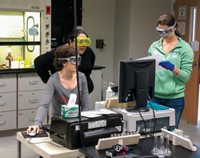Advertisement
Grab your lab coat. Let's get started
Welcome!
Welcome!
Create an account below to get 6 C&EN articles per month, receive newsletters and more - all free.
It seems this is your first time logging in online. Please enter the following information to continue.
As an ACS member you automatically get access to this site. All we need is few more details to create your reading experience.
Not you? Sign in with a different account.
Not you? Sign in with a different account.
ERROR 1
ERROR 1
ERROR 2
ERROR 2
ERROR 2
ERROR 2
ERROR 2
Password and Confirm password must match.
If you have an ACS member number, please enter it here so we can link this account to your membership. (optional)
ERROR 2
ACS values your privacy. By submitting your information, you are gaining access to C&EN and subscribing to our weekly newsletter. We use the information you provide to make your reading experience better, and we will never sell your data to third party members.
Education
Renewing Advanced Placement
The College Board is overhauling the AP chemistry curriculum and exam to focus on conceptual understanding
by Jyllian Kemsley
September 12, 2011
| A version of this story appeared in
Volume 89, Issue 37

Responding to long-standing criticism that its high school Advanced Placement (AP) courses were too broad and that students who took the classes had to rush through overwhelming amounts of material and didn’t develop a deep conceptual understanding of the subject matter, the nonprofit college preparation organization College Board is revamping all of its AP curricula and exams. For AP chemistry, the organization has laid out a new curriculum framework and is now developing a lab manual, exams, and teacher resource materials. The revised course may roll out as soon as the 2013–14 school year.
Perhaps the biggest change in the AP chemistry course will be the detailed curriculum framework itself, says Annis Hapkiewicz, a retired high school chemistry teacher and member of the College Board’s AP Chemistry Curriculum Development & Assessment Committee. Previously, the curriculum consisted of a set of broad bullet points, such as “equilibrium.” Teachers had to look at old exams to figure out what that meant.
COVER STORY
Renewing Advanced Placement
The new framework spells out specific learning objectives. For example, “The student is able, for a reversible reaction that has a large or small K, to determine which chemical species will have very large versus very small concentrations at equilibrium,” says a draft version of the framework provided to C&EN by the College Board. The framework also spells out what will not be on the exam: “Computing the change in pH resulting from the addition of an acid or a base to a buffer is beyond the scope of this course and the AP Exam,” the draft framework says.
The learning objectives themselves are rooted in six “big ideas” of chemistry and seven science practices. The big ideas center on the structure and properties of matter, changes in matter through chemical reactions, reaction kinetics, thermodynamics, and equilibrium.
The science practices are the skills that AP chemistry students should develop during the course. The practices include using models such as Lewis dot structures to solve problems or make predictions, developing experiments, and analyzing data. “Really they’re all the skills that a scientist uses,” Hapkiewicz says.
Revised AP Curriculum Centers On Six ‘Big Ideas’ About Chemistry And Seven ‘Science Practices’
Big ideas
1. The chemical elements are fundamental building materials of matter, and all matter can be understood in terms of arrangements of atoms. These atoms retain their identity in chemical reactions.
2. Chemical and physical properties of materials can be explained by the structure and the arrangement of atoms, ions, or molecules and the forces between them.
3. Changes in matter involve the rearrangement and/or reorganization of atoms and/or the transfer of electrons.
4. Rates of chemical reactions are determined by details of the molecular collisions.
5. The laws of thermodynamics describe the essential role of energy and explain and predict the direction of changes in matter.
6. Any bond or intermolecular attraction that can be formed can be broken. These two processes are in a dynamic competition, sensitive to initial conditions and external perturbations.
Science practices
1. The student can use representations and models to communicate scientific phenomena and solve scientific problems.
2. The student can use mathematics appropriately.
3. The student can engage in scientific questioning to extend thinking or to guide investigations within the context of the AP course.
4. The student can plan and implement data collection strategies in relation to a particular scientific question. [Note: Data can be collected from many different sources, e.g., investigations, scientific observations, the findings of others, historic reconstruction, and/or archived data.]
5. The student can perform data analysis and evaluation of evidence.
6. The student can work with scientific explanations and theories.
7. The student is able to connect and relate knowledge across various scales, concepts, and representations in and across domains.
To reduce breadth and allow for deeper learning, some topics have been eliminated from the course. Examples include exceptions to electron configuration rules, constant-volume calorimetry, and Lewis acids and bases. Students will no longer have to memorize extensive lists of solubility rules, weak acids and bases, or crystal structures. Feedback from college faculty also led the curriculum development committee to eliminate nuclear chemistry.
In exchange, students will need to be able to do things such as evaluate differing scientific explanations and connect concepts such as kinetics, equilibrium, and thermodynamics. “Students haven’t been asked to do that before,” says Serena Magrogan, director of AP science curriculum and content development at the College Board.
They will also work more with actual data, such as photoelectron spectra, and apply concepts such as weak bonding interactions to proteins, or equilibrium to environmental science. The increased incorporation of actual scientific data is something that Trinna McKay, director of the Advanced Placement Summer Institute in Science & Mathematics at Kennesaw State University and a member of the AP chemistry curriculum development committee, says is her favorite part of the new course. The goal is to get students to make connections between data and concepts, like ionization energies and the relationship between protons and electrons in atoms. Having the data makes students think about the concept in a different way, rather than simply memorizing what happens, McKay says.
Additionally, the College Board is adjusting the suggested AP chemistry laboratory curriculum. It’s paring the current 22 recommended labs down to 16, six of which will be inquiry-driven exercises in which the students will have to design and evaluate procedures to solve a particular problem.
An example of an inquiry-driven lab, Hapkiewicz says, is one in which she gives her students eight unknown solutions. She tells the students that four are acids and four are bases, that two of the solutions contain NaOH and HCl, and that the concentrations are 0.8, 0.4, 0.2, and 0.1 M. The students then have to develop their own experimental approach to determine the identity and concentration of each solution. Inquiry-driven labs generally take more time than labs that largely amount to following recipes, but students learn more overall, Hapkiewicz says—and the reduction in the number of labs suggested by the College Board should help to accommodate the approach.
Likewise, the number of questions on the AP exam will be pared back to allow for more questions designed to test conceptual understanding rather than memorization. The current 75 multiple choice questions will probably be reduced to 60, says David Yaron, a chemistry professor at Carnegie Mellon University and a member of the AP chemistry curriculum development committee. The exam will also likely have multiple questions related to one situation or set of information, to reduce the amount of time students need to spend reading. “We want to be careful that the questions are set up so that if you miss the first question you don’t necessarily miss the second,” Yaron says, “but we should still save students time by asking about the same situation.”
There will also be a general move toward qualitative rather than quantitative analysis on the exam. Historically, some students could solve problems by memorizing a flow chart or powering through some math but then be completely unable to answer simple qualitative questions. “Math is not the only source of rigor in science,” Yaron says.
The College Board first unveiled the revised curriculum to teachers at the AP Annual Conference, held in San Francisco in July. Reaction from teachers was largely positive. Siobhan Julian, a high school chemistry teacher at Webster Schroeder High School in Webster, N.Y., appreciated the shift to emphasize conceptual understanding, as well as the elimination of some topics. “We won’t feel the same sort of rush to get through the material,” she said.
“It’s nice to see the College Board being proactive about inquiry in science by formally making it a requirement for the course,” Julian added. “From what I understand, more colleges are moving toward this, so it’s fitting to carry it down to the high school level.”
David Smith, a chemistry teacher at Aiken High School, in Aiken, S.C., liked the new clarity of the curriculum framework. “It will take away a lot of the guesswork,” he said. And even though some topics have been eliminated from the course, as long as college faculty will still accept it for credit or class placement—something the College Board has tried to ensure through faculty review of the curriculum—he thinks teachers will be fine with the changes.
Having completed teacher and faculty review of the curriculum, the College Board is now working on writing exams and developing resources such as the lab manual, a practice exam, a syllabus development guide, and teacher professional development courses. A rollout date has not yet been set for the course, the College Board’s Magrogan says, but the organization wants to have the resources available to teachers two years before implementing the course. That means that the earliest it could start is in the 2013–14 academic year. “This is really a new way of thinking about AP science education, and we want to get it just exactly right,” Magrogan says.





Join the conversation
Contact the reporter
Submit a Letter to the Editor for publication
Engage with us on Twitter